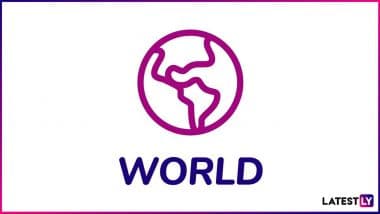San Juan, Aug 14 (AP) Ernesto strengthened into a hurricane Wednesday as it dropped torrential rain on Puerto Rico and left nearly half of all clients in the US territory without power as it threatened to become a major storm en route to Bermuda.
The storm was located about 225 miles (365 km) northwest of San Juan, Puerto Rico and was moving over open waters. It had maximum sustained winds of 75 mph (120 kph) and was moving northwest at 16 mph (26 kph).
Also Read | Live News Updates Today.
“The official forecast still reflects the possibility of Ernesto becoming a major hurricane in about 48 hours,” the National Hurricane Centre said Wednesday afternoon.
Tropical storm warnings were discontinued for Puerto Rico and its outlying islands of Vieques and Culebra and for the US and British Virgin Islands.
“I know it was a long night listening to that wind howl,” US Virgin Islands Gov Albert Bryan Jr said in a news conference.
An island-wide blackout was reported in St John and St Croix, and at least six cell phone towers were knocked offline across the US territory, said Daryl Jaschen, emergency management director.
He added that the airports in St Croix and St Thomas were expected to reopen at midday.
Schools and government agencies remained closed in the US Virgin Islands and Puerto Rico, where heavy flooding was reported in several areas, forcing officials to block roads, some of which were strewn with trees. More than 140 flights also were cancelled to and from Puerto Rico.
“A lot of rain, a lot of rain,” Culebra Mayor Edilberto Romero said in a phone interview. “We have trees that have fallen on public roads. There are some roofs that are blown off.”
The risk of flash flooding in parts of Puerto Rico remained in the afternoon because of the ongoing heavy rains, the hurricane center said.
Amid the relentless rain, officials opened one of Puerto Rico's biggest dams and evacuated some residents from the north coastal town of Toa Baja as torrents of churning brown water flowed toward it.
Ernesto is forecast to move through open waters for the rest of the week and make its closest approach to Bermuda on Friday and Saturday. It is expected to become a major Category 3 storm in the upcoming days and then weaken slightly to a Category 2 as it nears Bermuda.
“Residents need to prepare now before conditions worsen,” said Bermuda's National Security Minister Michael Weeks. “Now is not the time for complacency.”
Forecasters also warned of heavy swells along the US East Coast.
“That means that anybody who goes to the beach, even if the weather is beautiful and nice, it could be dangerous...with those rip currents,” said Robbie Berg, warning coordination meteorologist with the National Hurricane Centre.
Between 4 to 6 inches of rain is expected in the US and British Virgin Islands and between 6 to 8 inches in Puerto Rico, with up to 10 inches in isolated areas.
Late on Tuesday, the US Federal Emergency Management Agency had warned people in both US territories to prepare for “extended power outages”.
More than 700,000 customers were without power in Puerto Rico, along with 23 hospitals operating on generators, Gov Pedro Pierluisi said Wednesday. He added that crews are assessing damage and that it was too early to tell when electricity would be restored.
“We are trying to get the system up and running as soon as we can,” said Juan Saca, president of Luma Energy, the company that operates transmission and distribution of power in Puerto Rico.
Luma Energy said earlier Wednesday in a statement that its priority was to restore power to hospitals, the island's water and sewer company and other essential services. Some 235,000 customers were without water as a result of power outages, Pierluisi said.
Puerto Rico's power grid was razed by Hurricane Maria in September 2017 as a Category 4 storm, and it remains frail as crews continue to rebuild the system.
“It's just frustrating that this many years later, we continue to see something like a storm cause such widespread outages in Puerto Rico, particularly given the risk that these outages can cause for vulnerable households in Puerto Rico,” said Charlotte Gossett Navarro, the Hispanic Federation's chief director for Puerto Rico.
Not everyone can afford generators on the island of 3.2 million people with a more than 40% poverty rate.
“People already prepared themselves with candles,” said Lucía Rodríguez, a 31-year-old street vendor.
Rooftop solar systems are scarce but keep growing in Puerto Rico, where fossil fuels generate 94% of the island's electricity. At the time María hit, there were 8,000 rooftop installations, compared with more than 117,000 currently, according to the Institute for Energy Economics and Financial Analysis.
Pierluisi announced late Tuesday that US President Joe Biden had approved his request to use emergency FEMA funds if needed as a result of the tropical storm.
Ernesto is the fifth named storm and the third hurricane of this year's Atlantic hurricane season. Since 1966, only four other years have had three or more hurricanes in the Atlantic by mid-August, according to Philip Klotzbach, Colorado State University hurricane researcher.
The National Oceanic and Atmospheric Administration has predicted an above-average Atlantic hurricane season this year because of record warm ocean temperatures. It forecast 17 to 25 named storms, with four to seven major hurricanes of Category 3 or higher. (AP)
(This is an unedited and auto-generated story from Syndicated News feed, LatestLY Staff may not have modified or edited the content body)













 Quickly
Quickly
















